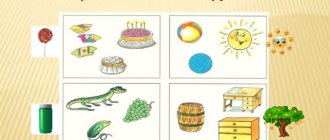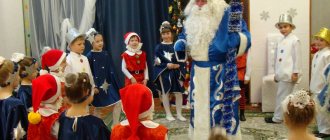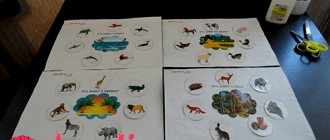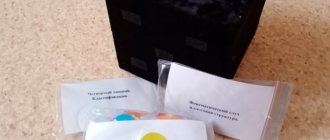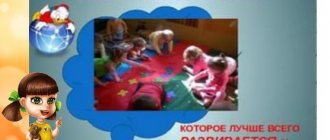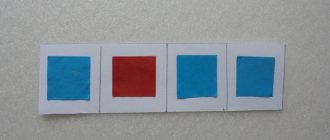A series of educational board games about your hometown
Municipal preschool educational budgetary institution
“General developmental kindergarten No. 25 “Crane”
Arsenyevsky urban district
Board-printed didactic game
“In the city of Arsenyev there is...”
Author: Elena Pavlovna Vetrova, teacher of Children’s Preschool Institution No. 25 “Crane”
Arsenyev
2018
This game can be used in direct educational activities, during interaction between adults and children in restricted moments, and in independent play activities.
Name of the game:
"Loto "My city - Arsenyev"
Children's age
: 4-6 years.
Game task:
it is necessary to select part pictures for the corresponding urban object.
Didactic tasks
:
Expand children's ideas about the city, its enterprises (Arsenyevsky milk, the Cosmos cinema, the Progress cultural palace, which houses the Veselaya Arena circus studio). Continue to cultivate love for your hometown.
Develop cognitive processes: attention, memory, thinking and speech.
Rules of the game
:
1 child can participate in the 1st version of the game. He must lay out all the subject pictures on game cards;
In the 2nd version of the game, 4 children (according to the number of game cards) and the presenter can participate. The teacher may be the leader at the initial stage. Next, the role of the leader can be played by the child. Each player is dealt a game card (4 game cards in total). At the initial stage, the presenter shows a picture, talks about the place depicted on it, or the children themselves guess the place. When playing again, the children themselves name the place and talk about it. The first player to cover his entire card wins.
Progress of the game, organization of children for the game:
1. Option.
Introduction to the game.
The child is asked to look at object pictures that are placed in one pile. The teacher explains that the “Mixed Up” Wizard came and mixed everything up and that all the pictures need to be put in their places.
Option 2.
Introduction to the game.
The teacher invites the children to get acquainted with the new game (4 children participate, the rest can watch the progress of the game). Children look at game cards (fields). The teacher explains the rules of the game to the children. Participants choose a game card as desired. The teacher-leader shows the pictures one at a time. The child who has this object on the card takes the picture for himself and covers the field of the card with it.
When playing again, the role of the leader can be played by the winner or determined using a counting rhyme.
Game clarification:
In the future, game cards (fields) can be supplemented with new cards with new enterprises, that is, thereby expanding the game.
Materials used:
The pictures used in the game were found freely available on the Internet.
Photo of the game “In the city of Arsenyev there is...”
Municipal preschool educational budgetary institution
“General developmental kindergarten No. 25 “Crane”
Arsenyevsky urban district
Board-printed didactic game
"Memory"
Author: Elena Pavlovna Vetrova, teacher of Children’s Preschool Institution No. 25 “Crane”
Arsenyev
2018
This game can be used during interaction between adults and children in routine moments and in independent play activities.
Name of the game:
"Memory"
Children's age
: 5-7 years.
Game task:
find paired cards and collect as many of them as possible.
Didactic tasks
:
Expand children's ideas about the city and its attractions.
Continue to cultivate love for your hometown.
Develop children's visual memory, attentiveness, perseverance, imaginative and logical thinking.
Obey the rules of the game (keep the queue, etc.).
Rules of the game
:
The number of players is from 2 to 6 participants, depending on the number of cards.
The game is played with two identical decks of cards, with pictures on the front side.
Before the start of the game, all cards are shuffled and laid out in rows with the front side (picture) down. Players take turns opening (turning over) 2 cards. If identical cards are opened, the player takes them for himself and opens the next pair of cards. If the cards do not match, the player puts them in their original place face down and the right to move passes to the next participant. When unpaired cards are returned to their place, all players try to remember where each picture is.
The player with the most cards wins.
Progress of the game, organization of children for the game:
Children are invited to look at object pictures that depict some objects of the urban environment, name them, and talk about them. Next, the teacher invites the children to get acquainted with the new game. The teacher explains the rules of the game to the children. For the first time, the teacher can start the game first. The participant who opens two identical cards takes them for himself. When playing again, the first player is determined by a counting rhyme.
Materials used:
The pictures used in the game were found freely available on the Internet.
Municipal preschool educational budgetary institution
“General developmental kindergarten No. 25 “Crane”
Arsenyevsky urban district
Board-printed didactic game
Adventure game "City route"
Author: Elena Pavlovna Vetrova, teacher of Children’s Preschool Institution No. 25 “Crane”
Arsenyev
2018
This game can be used during interaction between adults and children in routine moments and in independent play activities.
Name of the game:
"Adventure game "City route"
Children's age
: 5-7 years.
Game task:
travel around the city, see all the sights and return back.
Didactic tasks
:
Expand children's ideas about the city and its attractions.
Continue to cultivate love for your hometown.
Develop cognitive processes: attention, thinking and speech.
Practice counting.
Obey the rules of the game (keep the queue, etc.).
Equipment:
a playing field with tracks, a cube for determining the number of moves and chips of different colors.
Rules of the game
:
The game can be played by 2 to 4 players.
You need to put chips on the “Start - “Bus Stop” sign. Players take turns and perform step-by-step actions from start to finish. On his turn, the player rolls the dice and moves his piece forward exactly as many steps as the number of points on the dice. A player's piece can move past steps occupied by other players' pieces or stop on them.
If the chip stops on a red circle, the player skips his move; if the chip stops on a green circle, then he moves along the arrow to another circle.
Progress of the game, organization of children for the game:
Introduction to the game. The teacher offers a new game: “There are many amazing places in our city, let's take a trip around our city by bus (car, bicycle). But on the road, some rules of movement are always followed.” Explains the rules of the game.
To begin, players must choose the color of their game piece and determine who will go first by rolling the dice. Then, one by one, they roll the dice and move the number of moves they roll.
Materials used:
The pictures used in the game were found freely available on the Internet.
Didactic material on the topic “Our home, our city, our country”
Assignment: Read a story to your child, answer questions with him, and then play games.
“There are a lot of countries on Earth. Our country is Russia. This is our Motherland, the place where you were born, where you live with your parents and friends.
Each country has a flag, anthem and coat of arms. Our Russian flag has three stripes. White means purity and justice. Blue is a peaceful sky. Red - strength and beauty. This flag was introduced into Russia by Tsar Peter the Great. When the national anthem is played and the national flag is raised, the citizens of this country stand.
Each country also has its own coat of arms. The coat of arms of Russia is a double-headed eagle.
Our Motherland is huge, it has a lot of cities, villages, rivers, lakes, seas. The most important city in the country is called the capital. The capital of Russia is the city of Moscow. You live in a city, town or village, and this place is necessarily marked on the map.
But besides this, each person has his own home. People all over the world live in a wide variety of homes. They build them from various materials. Some houses are built of brick or stone, others of wood, clay or reeds.”
Ask your child questions:
— What is the name of our country? Name the capital of our Motherland. — What color is the flag of our country? — Who introduced this flag into Russia? — What is the name of your hometown or village? - Give me your home address. — What material can people build their house from?
1. Complete the sentence.
My country is called ... (Russia) The capital of our country is ... (Moscow city) My city (village) is called - ... My home address is ...
2. Choose as many words as possible to match the adult’s word.
Country (which?) -... (huge, beloved, beautiful, only, rich, powerful, endless) City (which?) -... (big, small, clean, green, well-groomed, dear, etc.)
3. Who lives in their native land? Circle the plants and animals that can be found in your area.
4. There is always a lot of traffic on the streets of our cities and therefore you need to be careful. Look at the pictures and tell which child is behaving incorrectly. Highlight them.
5. A red car drives to a house with a blue garage. Travel with the car: tell it what it will go past, where it will turn, where it will stop and why before it reaches the garage.
6. Name the parts of the room and the house.
Door, window, ceiling, floor, walls.
Balcony, stairs, roof, walls, windows, doors. (House)
7. Help each hero find his home. (Draw the lines). Think like this: “Carlson lives on the roof,” etc.
8. Name the rooms in the house.
Living room, bedroom, hallway, bathroom, children's room, kitchen, utility room (storage room), dining room.
9. Choose as many words as possible that will tell you what we do in different rooms of the house (apartment).
In the living room (what are they doing?) – watching TV, relaxing, receiving guests. In the bedroom (what are they doing?) - they sleep, rest, In the hallway (what are they doing?) - they dress, undress, take off their shoes, put on their shoes, greet, see off (guests). In the bathroom (what are they doing?) - they wash, shower, take a shower, bathe, brush their teeth, comb their hair, etc. In the nursery (what are they doing?) - they play, teach, study, sleep, relax, etc. In the kitchen (what are they doing?) - they cook, boil, fry, cut, wash (dishes), eat, etc. In the dining room (what are they doing?) - they have breakfast, lunch, dinner.
10. Tell us what houses are like.
The house has many floors - it is... (multi-storey) The house has one floor - it is... (single-storey) The house has many apartments - it is... (multi-apartment) The house has one entrance - it is... (single entrance) The house has many entrances - it is (multi-entrance) House built of brick - it is ... (brick) Made of wood - ... (wooden) Of blocks - ... (block)
11. Who do you think the artist forgot to draw in the empty window? Finish it.
12. Think and tell where Pinocchio is standing, using the words at, for, because of, between, right, left.
Pinocchio is standing behind the house. To the right of Buratino is a one-story house. To the left of Buratino is a multi-storey building. Buratino stands between a multi-story and a one-story building. Pinocchio is standing near the house. Pinocchio looks out from behind the house.
13. The tallest clown lives in a house, to the right of which a birch tree grows, the shortest one lives in a house, behind which a Christmas tree grows. Draw lines from the clowns to their houses.
14. Compose the story “Home Alone” from the pictures and write it down. Don't forget to put it in your story book.
Sample story:
“Vanya and his faithful friend Tuzik love to play together. But Vanya goes to school and cannot play with Tuzik all the time. Before leaving for school, Vanya strictly ordered Tuzik not to be naughty and to behave exemplarily. But after the boy left, Tuzik became bored and forgot about what Vanya was punishing him. He grabbed the tablecloth in his teeth and began to rush around the house with it. When the boy returns from school, he will have to put his house in order for a long time.”
Teacher-speech therapist Gomzyak Oksana Stepanovna
- Summary of a speech therapy lesson on the topic “Our Country”
- Summary of the educational activity “We love our city very much”
- Summary of logorhythmic lesson [Country Mylyandiya]
- Scenario for speech therapy leisure “Journey to the City of Beautiful Speech”
- Summary of a lesson on teaching older preschoolers literacy “Journey to the city of Zvukograd”
( 7 liked, average score: 5.00 out of 5)
Loading...
